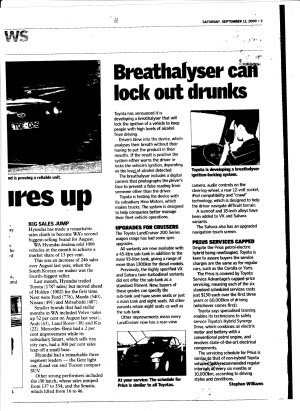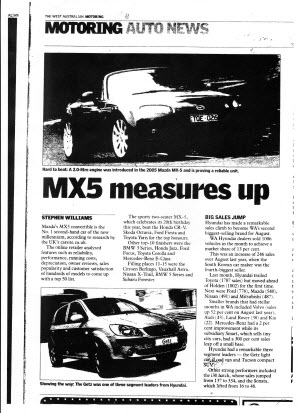If there is anything that’s sure to sell a car other than a flashy advertising campaign, it’s a glowing endorsement from a leading motoring publication.
For car companies, it’s a cost effective measure and in their best interest to have journalists driving and reporting on their cars, happily funding journalists to attend their interstate and international launches. In a round fuelled by product launches, motoring journalists are obligated to attend these events or miss the story, yet despite increasing time pressures and a heavy reliance on manufacturer contacts and information, they argue that their journalistic integrity has not suffered as a result of the cosy relationship.
The ACIJ’s analysis of motoring articles in our Spinning the Media investigation found over 64 percent of stories across all ten newspapers were generated by public relations, with nearly 26 percent of all articles lacking significant extra work by the journalists apart from drawing on the original press release. (To see how we did this, go here.)
Motoring journalist for the West Australian Stephen Williams said that the level of public relations penetration into motoring coverage – including review trips funded by manufacturers – is entirely necessary.
“The relationship is almost completely about getting coverage about the latest and newest products,” Williams said.
“The reality is that if the car companies didn’t take us, we wouldn’t be able to report on the car – we can’t just go off press releases and write about cars we haven’t driven. Our independence can be doubted by this external perception, but from our point of view we are independent and this system works very well.”
Yet in the West Australian’s motoring supplement for September 12, 2009, four media releases appeared on the paper’s Auto News page almost completely unedited, with Williams’ byline attached:
Check out the media releases here, here, here and here. Williams would not comment on this when queried by the ACIJ on this example, except to state that his department does an independent and critical analysis of every press release.
Editor of Drive for the Fairfax broadsheet newspapers Steve Colquhoun said that maintaining a close relationship with car manufacturers is part and parcel for covering the motoring round. “I have daily interaction with car companies,” he said.
Mr Colquhoun described car launches as a “win- win” situation for car companies and journalists – both need the story.
Drive’s national editor Toby Hagon says that a raft of new online motoring publications have increased the amount of wholly PR-generated coverage.
“There are lots of people who just reproduce the press kits or the press releases,” Hagon said. “You’re never going to win the game reproducing press kits – everyone’s doing it. There are some press releases you just can’t ignore – but I always say to the guys that I want to learn something that wasn’t in the original press release, that they need to add depth to every article.”
The MEAA code of ethics requires journalists to disclose conflicts of interest that could affect the accuracy, fairness or independence of their reporting. Why, then, do motoring journalists not disclose that their airfares and accommodation has been paid for by the car companies?
Drive is the only Australian metropolitan newspaper with a code of ethics relating to subsidised travel and accommodation. However, Drive’s code of ethics works more as a blanket set of guidelines, and does not require disclosure.
“We’d ideally disclose every single trip in isolation,” said Mr Hagon, “but then it becomes a bit of a grey area. For example, I went to the Tokyo Motor Show about six weeks ago… and at these things you learn a lot of background stuff from the interviews you do there, knowledge that could be used in a number of articles down the track… potentially a story could have two or three disclaimers.”
Last September, Land Rover bankrolled a lavish trip around the United Kingdom for at least three Australian motoring journalists for the launch of the 2010 Range Rover Vogue. Anthony Crawford, writing for Caradvice.com.au, even filed a diary of happy snaps and press shots from his travel experiences before driving any of the vehicles. The Daily Telegraph’s Kevin Hepworth presented the launch as a feature of the review, but at least the trip was disclosed. Yet Drive’s Barry Park, whom Drive editor Steve Colquhoun told the ACIJ had attended the launch, omitted any mention of the trip in his write up.
Perhaps the vehicle was perfectly flawless, but it is also plausible that an absence of critical commentary in the above reviews could be perceived as a result of journalists’ hands-on time with the vehicles being managed entirely by the manufacturer.
Motoring editor for the Courier Mail Mark Hinchliffe said that increasingly extravagant, orchestrated travel trips for reviews impede the reporter’s ability to report on the vehicle.
“With some launches, you’re lucky if you get to drive the car for a couple of hours, and you’re away from the office for two days… They try to dazzle you with exotic locations – it’s really just a waste of time,” Hinchliffe said.
Beyond the glitz of new model review trips in faraway places, many carmakers like to present journalists with tokens of appreciation. Mr Hagon said that whilst the majority of carmakers, including Australian manufacturers Holden, Toyota and Ford, maintain a policy against giving gifts, the practice occurs regularly.
“Sometimes we get model cars after they’ve been used for a photo shoots, which happens one in every three to four launches,” he explains. “Sometime the car companies will offer us iPods, but this comes up once every six to twelve months, so it’s the exception rather than the rule. I got a Porsche book, which was a history of Porsche. And I took that, because it can be used for research, for articles, for background down the track.”
Mr Hagon said that the Drive code of ethics places an upper limit on the value of gifts that can be accepted, but the level of adhesion appears to be decided by the journalist being propositioned.
So besides one publication’s voluntary code of ethics and a “scout’s honour” approach to independence from editorial staff, Crikey/ACIJ’s investigation found startlingly few mechanisms to regulate the influence of car manufacturers in the motoring coverage we analysed. It seems that for such a powerful industry, opaque disclosure about media-managed review events and a heavy reliance on PR communications should be a big red warning light for Australian motorists.
Daniel Bishton is completing a Masters of Journalism student at the University of Technology, Sydney. Alexander McGhee is a recent graduate in Journalism International Studies at the University of Technology, Sydney .










The way car company publicists and motoring writers work together in New Zealand is exactly the same. It’s hard to say whether this is good or bad. It just seems to be the way things are, and I think car enthusiasts understand this is the way things work. What do others think about the car article readers? Isn’t it a little like accepting a flight or accommodation for a travel article with the expection of the provider that the article will be favourable? Again, not 100% independent, but the way that the writer/publication continues to have access to the products and services they write about.
I’m a little puzzled. Your two students write about car reviews being supposedly influenced by press releases, but the four examples cited have no relation to reviews. They’re news about technology updates. Also, I was surprised to see two journalism students/graduates who are allegedly conducting ‘research’ use terms like ‘the journalist PROPOSITIONED’ … is that not the kind of perjorative language that would be frowned on in any research methodology — and particularly in journalism research?
Try replacing every mention of car, motoring, and driving with game, video game, and playing respectively. Not that video game journalism should be considered journalism mind you. But it does go to show the problems that arise in an area or round when the primary source of news is carefully controlled public relations, and is supported by a culture of subtle bribes in the form of free holidays and gifts.
There is a difference between a car launch and a car review, and more specifically between a manufacturer-organised event and a loan of a press vehicle. With the former it’s all about glitz and sales. Whatever driving you do is shared and in circumstances designed to show the car off and avoid its negatives.
If you collect a press car for test then there is none of that. You do what you want with the vehicle for the alloted amount of days — usually 2-5, or maybe more if it’s a long-term test — and hand it back, ideally in one piece. That is where and how a journo really can evaluate a vehicle. The only time you speak to the PR people is to book the car, or maybe the editor even does that.
I think this piece is quite biased, it’s clearly looking for a cheap headline — “lazy corrupt journos in the pockets of car makers!!!!” — instead of taking the time to properly evalulate the facts. Given I have some knowledge of this part of the industry and don’t know the rest, the remainder of the study is now thrown into doubt for me. Can’t Crikey leave sensationalism to the tabloids? Having said that I agree there should be some form of ethics code.
As for car enthusiasts…many of them are convinced that the journos/mags are paid by the manufacturers for the stories, but never seem to be able to provide any evidence other than that fact there was negative comment against their favourite vehicle. Funnily enough the Toyota owners are convinced there is bias against Toyotas, the Nissan owners are sure they are discriminated against and so on. It is even possible to be accused of bias by up to three enthusiasts with totally different opinions about the same article, each reading what they want to see to fuel their opinions.
And the Range Rover is not perfectly flawless, just close to perfectly flawless 😉